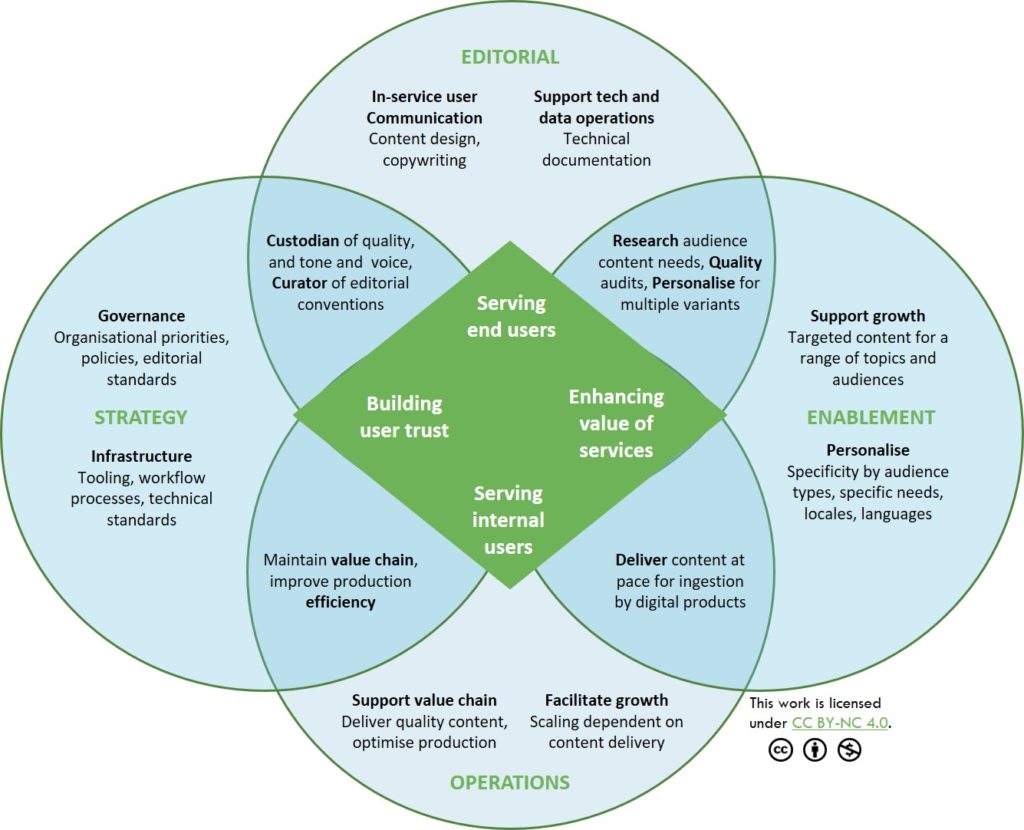If you know about content strategy from the practitioner’s point of view, you’ll know that we like our quads. (To be fair, our field of practice practically lives in spreadsheets. But let’s face it, spreadsheets don’t make for sexy visuals.) Do a Google image search on quads, and you’ll find square quads, round quads, quads that aren’t quads at all – given that quad means “four” and a quad with 3 sides is a triple. Quads are so ubiquitous that I even incorporated it as an element in my new company logo. (If you’re having trouble parsing the previous sentence, it’s a new company and so a new logo.)
Content production is evolving, and with each change, we look for new ways to represent those changes. Despite not liking the term quad for its lack of semantics, I realise the usefulness of the quad style of infographic. It’s easy to visualise information in groups of four, or divisions by four. In that spirit, I’m introducing a new quad for content.
The need for a new quad
If there’s a common theme among clients or employers, it’s an overwhelming lack of understanding of how complex it is to produce content. They don’t understand the strategy aspect, the operational aspect, or the potential that they’re missing out on. They think they understand what it takes to write and edit content, but get into the topic a little deeper, and they don’t know anything about the complexity. And don’t get me started on the lack of knowledge about localisation. Or personalisation. Or operations.
There’s an assumption that “writing and editing” is the sum of content production. The implicit end of that sentence is “unlike producing code, which is complicated and makes the magic happen”. Pffft. The nuanced complexity of content leaves the complications of code in the dust.
Trying to show the depth of content and the connection between strategy, editorial, operations, and growth took a lot of thought and fiddling around with graphic representations. For better or worse, I decided that a quad in the form of a Venn diagram overlaid by a diamond worked best.

A quad for all seasons
OK, a bad pun on A Man for All Seasons. Notice that I’m calling this a content quad. It’s not a content strategy quad – content strategy is only one aspect of the graphic. In this quad, we consider the entire content ecosystem. Content is so much more than what is represented in any single quadrant. It’s not just web content or just marketing content or just editorial or just…well, you get the picture.
Interpreting the infographic
A good start is with the centre diamond. The four outcomes are general, not intended to be attached to any one of the quadrants. Having said that, the position of each of the outcomes has more relevance to the nearest quadrant.
The strategy
The strategy aspect is exactly that – planning out what to do to make the content ecosystem work. The strategy is not the implementation nor is it the ongoing doing of the work. A content strategy in itself is only useful if the strategy gets implemented. Commissioning a content strategy only to put it into a drawer is not helpful. In fact, it’s more frustrating for the content professionals it’s supposed to help because you’ve held out hope and then watched it die through management inertia.
If a strategy is a plan, then what are you planning for? The outcome of the strategy is some sort of operational model for content. Another way of putting this is that you are turning content chaos into a functioning system. The idea is to support the production of content, whether that is through better editorial processes that increase content quality, or through better technical underpinnings to optimise production. Layered over this is governance, which affects both the editorial and technical sides, and other things such as change management, training, and standards.
Operations
To clarify, strategy is planning for how your copy will get created and managed. Content operations is the manifestation of the strategy. The Operational Leaders podcast host, Terrance O’Malley, refers to this as “the business that runs the business”. No matter what industry vertical your organisation is in, there are operational models in place to make the business run smoothly. Finance has an operational model for accounting; HR has an operational model for recruitment; Administration has an operational model that controls inventory, maintenance, and other things that make a workplace run smoothly. The content operations model gives you a system to be able to create content, day in and day out, in an efficient way. One example is content modelling. It is part of the strategy, as content modelling helps set up the infrastructure. Using the content model to create content on an ongoing basis is part of operations.
Editorial
At the top is the editorial quadrant. This is the area that most content producers are familiar with. Either we have started out as a content developer of content genre or another – anything from business communications, marketing communications, technical communications, ecommerce, journalism, or even fiction – or perhaps we’ve come to our jobs through translation and localisation, or some production control such as supply chain management. No matter how we came to the industry, we recognise that at the core of what we do is good copy. It’s not enough to produce bad content more efficiently. The consumers of our content will judge us on the quality of what we’re serving up for consumption. Those consumers are largely potential or existing customers. The forgotten consumer segment is often those who need good content the most – the developers and technical audiences who are dependent upon clear, precise instructions to set up and configure equipment, implement APIs, and administer the systems that support operations. The impetus to create good content is the same, no matter who the audience. If your message cannot be understood, all the strategy and operational support you can throw at it won’t help. Investing in good quality copy is the biggest service you can provide to your end users.
Enablement
The final quadrant is labelled Enablement, as information enablement is the key to adding value, whether that is enabling publishing at scale, producing at pace, managing risk, expanding scope, or enabling personalisation. Enabling growth and personalisation are the two most-discussed aspects of content at the moment. Personalisation, in particular, is today’s holy grail in terms of delivering value of a product or service. By its very nature, personalisation and scale go hand in hand. Personalisation for multiple audiences means multiple content variants. Multiple audiences, industries, locations, languages means a steep increase in content volume, and that means more operational horsepower is needed to manage it. There is no single way to manage that type of content, just as there is no single way that a store arranges its merchandise. But you can get that a store of any substantial size has an inventory management system to keep track of stock. Supporting growth is an integral part of enhancing value of the products and services provided by our organisations.
The intersections
Of course, each quadrant does not exist in a silo. They overlap in multiple ways, some of which are impossible to show in a 2D graphic. However, I’ve called out the strongest intersections between adjacent quadrants. Finding your own (dare I say personalised?) intersections may spark some aha moments specific to your organisation. You may have NLP as a factor, or machine learning, or chatbots. You may need to support an artificial intelligence model, augmented reality, or otherwise connected products. Any of these may spark additional ideas.
Neither beginning nor end
This is by no means the first content-related quad that’s come along, and it certainly won’t be the last. I’ve been in the business of producing content since 1989, and have watched the evolution of content production change at a steady pace. Each time it seems that there may be a plateau, technologies change, and with it, the complexities of producing content. Even the things that seem constant – principles of comprehension, reading patterns, attention span, cognitive loads, learning methods – have not remained static. This decade, we’re poised to take the next step up along our journey toward industry maturity.

ABOUT THE AUTHOR
Rahel Anne Bailie, Content, Seriously
Rahel is a results-driven, seasoned consultant with extensive experience in digital transformation. She has a strong track record of delivering end-to-end content systems in the context of digital strategy projects, often in environments with complex content delivery requirements. A professional who delivers the hard truths and sometimes difficult prescriptions that help organisations leverage their content as a business asset.


 What is content operations?
What is content operations?